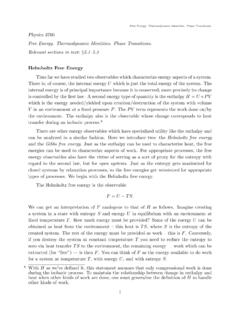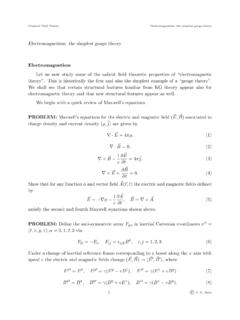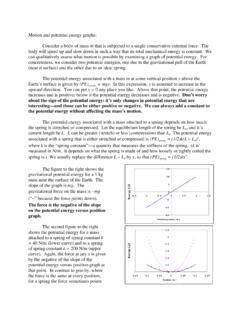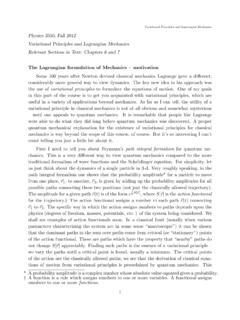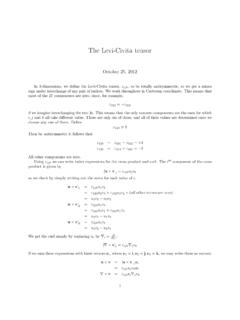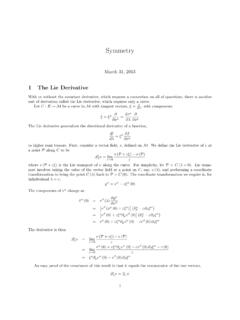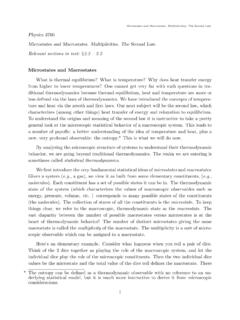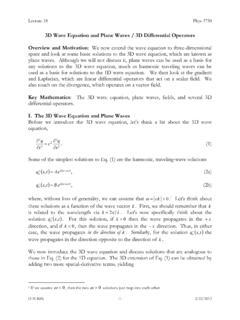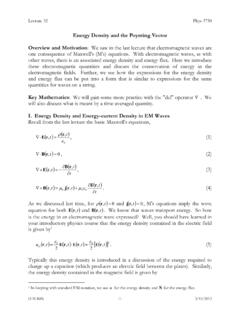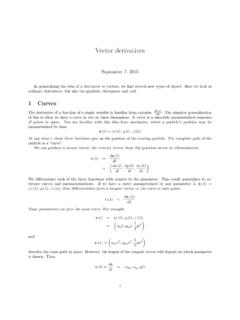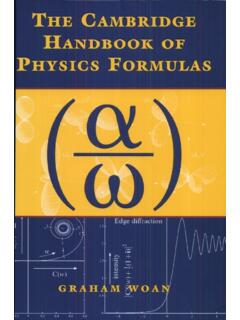Transcription of Gravitational Waves - Utah State University
1 Gravitational WavesIntuition In Newtonian gravity, you can have instantaneous action at a distance. If I suddenlyreplace the Sun with a 10,000M!black hole, the Earth s orbit should instantly repsond inaccordance with Kepler s Third Law. But special relativity forbids this! The idea that Gravitational information canpropagateis a consequence of special relativity:nothing can travel faster than the ultimate speed limit,c. Imagine observing a distant binary star and trying to measure the Gravitational field atyour location. It is the sum of the field from the two individual components of the binary,located at distancesr1andr2from you. As the binary evolves in its orbit, the masses change their position withrespecttoyou,and so the Gravitational field must change.
2 It takes time for that information to propagatefrom the binary to you tpropagate=d/c,wheredis the luminosity distance to the binary. The propagating effect of that information is known asgravitational radiation, which youshould think of in analogy with the perhaps more familiarelectromagnetic radiation Far from a source (like the aforementioned binary) we see the Gravitational radiation fieldoscillating and these propagating oscillating disturbances are calledgravitational Waves . Like electromagnetic Waves ! Gravitational Waves are characterized by a wavelength and a frequencyf! Gravitational Waves travel at the speed of light, wherec= f! Gravitational Waves come in two polarization states (called + [plus]and [cross])The Metric and the Wave Equation There is a long chain of reasoning that leads to the notion of Gravitational Waves .
3 Itbegins with the linearization of the field equations, demonstration ofgauge transformationsin the linearized regime, and the writing of a wave equation for small deviations from thebackground spacetime. Suffice it to say that this is all eminently well understood and canbe derived and proven with a few lectures of diligent work; we will largely avoid this here in1 Relativistic Astrophysics Lecturefavor of illustrating basic results that can be used in applications. The traditional approach to the study of Gravitational Waves makes the assumption thatthe Waves are described by a small perturbation to flat space:ds2=g dx dx =( +h )dx dx where is the Minkowski metric for flat spacetime, andh is the small perturbations(and often called thewave metric).
4 The background metric, is used to raise and lowerindices. Amoregeneraltreatment,knownastheIsaacson shortwave approximation, exists forarbitrary background spacetimes such thatds2=(g +h )dx dx This approximation works in situations where the perturbative scaleof the wavesh is muchsmaller than the curvature scale of the background spacetimeg . A useful analogy to bearin mind is the surface of an orange the large scale curvature of theorange (the backgroundspacetime) is much larger than the small scale ripples of the textureon the orange (the smallperturbations) If one makes the linear approximation above, then the Einstein Equations can be reducedto a vacuum wave equation for the metric perturbationh :!
5 H =( 2 t2+ 2)h =0 h , =0 We recognize this is a wave equation, so let s assume that the solutions will be plane wavesof the formh =A exp(ik x )whereA is a tensor with constant components andk is a one-form with constant compo-nents. Taking the first derivative of the solution yields (remember the componentsA andk are assumed to be constant)h , =k h Taking a second derivative gives us the wave equation back: h , = k k h =0 The only way for this togenericallybe true, is ifk is null k k =k k =02 Relativistic Astrophysics LectureWe callk the wave-vector, and it has componentsk ={ ,&k}. The null normalizationcondition then gives thedispersion relation:k k =0 2=k2 The clean, simple form of the wave-equation noted above has an explicitly chosen gaugecondition, calledde Donder gaugeor sometimesLorentz gauge(or sometimesharmonicgauge, and sometimesHilbert gauge):h , =0 Sinceh is symmetric, it in principle has 10 independent coordinates.
6 The choice of thisgauge is convenient; it arises in the derivation of the wave equation,and its implementationgreatly simplifies the equation (giving the form noted above) by setting many terms to is very analogous (and should seem familiar to students of electromagnetic theory) tothe choice of Coulomb gauge (& &A= 0) in the derivation of the electromagnetic waveequation. The choice to use de Donder gauge is part of the gauge freedom we have the freedomtochoose coordinates. There are plenty of coordinate systems we could choose to work in,and not haveh , = 0, but the equations would be much more complicated. There is no apriori reason why that should bother us, except it becomes exceedingly difficult to separatecoordinate effectsfromphysical effects(historically, this caused a tremendous amount ofconfusion for the first 30+ years after Einstein discovered the first wave solutions).
7 One can show that choosing de Donder gauge does not use up all thegauge freedom,because small changes in coordinates x =x + preserves the gauge if , , = 0. This freedom indicates there is still residual gauge freedom,which we can use to simplify the solutions to the wave equation. The residual gauge freedom can be used to further constrain thecharacter ofA . It isdesirable to do this, because once all the gauge degrees of freedom are fixed, the remainingindependent components of the wave-amplitudeA will be physically important. We willskip the derivation, and State the conditions. Using de Donder on our wave solution, we findA k =0which tells us thatA isorthogonaltok . We additionally can demand (the gory detailsare in Schutz, most introductory treatments on Gravitational Waves ; a particularly extensiveset of lectures can be found in Schutz & Ricci Lake Como lectures, ):A =03 Relativistic Astrophysics LectureandA u =0whereu is a fixed four-velocity of our choice.
8 Together, these three conditions onA arecalled thetransverse-traceless gauge. What does using all the gauge freedom physically mean? In general relativity, gaugefreedom is the freedom to choose coordinates. Here, by restricting the gauge in the waveequation, we are removing thewaving of the coordinates, which is not a physical effect sincecoordinates are not physical things (they are human constructs). In essence, if you have aset of particles in your spacetime, the coordinates stay attachedto them (this, in and ofitself, has no invariant meaning becauseyou made up the coordinates!. What is left is thephysical effect, the waving of the curvature of spacetime. In the transverse-traceless (TT) gauge, there are only 2 independent components ofA :ATT = 00 0 00 AxxAxy00 Axy Axx000 0 0 So what is the physical effect of this wave?)
9 If we want to build experiments to detect thesewaves, this question is paramount we have to know what to look for! You might naively look at the geodesic equation and ask what effect thewavehasonparticle s trajectory,u , if that particle is initially at rest (for instance, in the corner of yourlaboratory). This is an exercise left to the reader, but you will find that given the form ofA above, the acceleration of the particle is always zero. If the particle is at rest and neveraccelerates, it stays at rest! This should not surprise us; we said above that the choice of gauge was made to stop thewaving of our coordinates! The particle stays at rest because it is attached to the coordinates! Experiments should be built around observations that can be used tocreateinvariantquantitiesthat all observers agree upon.
10 So rather than asingletest particle, imaginetwoparticlesand compute theproper distancebetween them. Imagine both particles begin atrest, one atx 1={0,0,0,0}and the other atx 2={0,(,0,0}:)= ds2= |g dx dx |1/2 Because the particles are separate along thex axis, we integrate alongdxand this reducesto)= $0|gxx|1/2dx&|gxx(x=0)|1/2(&[1+12hTTxx(x =0)](4 Relativistic Astrophysics Lecture Now our imposed solution forhTT is a travelling planewave, sohTTxxis not (in general)going to be independent of proper distance between our test particles changes intime. This is simplygeodesic deviation, which is the relative trajectories of nearby geodesics incurved spacetime. The Gravitational wave is curving the spacetime, which we can detect bythe geodesic deviation it introduces ( Gravitational tidal forces).)
